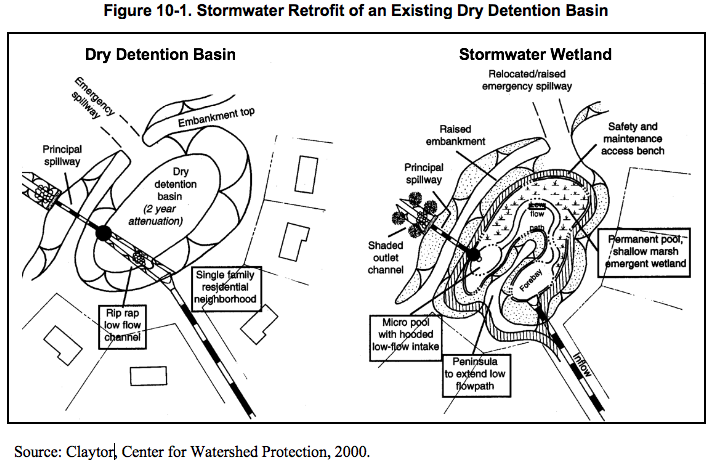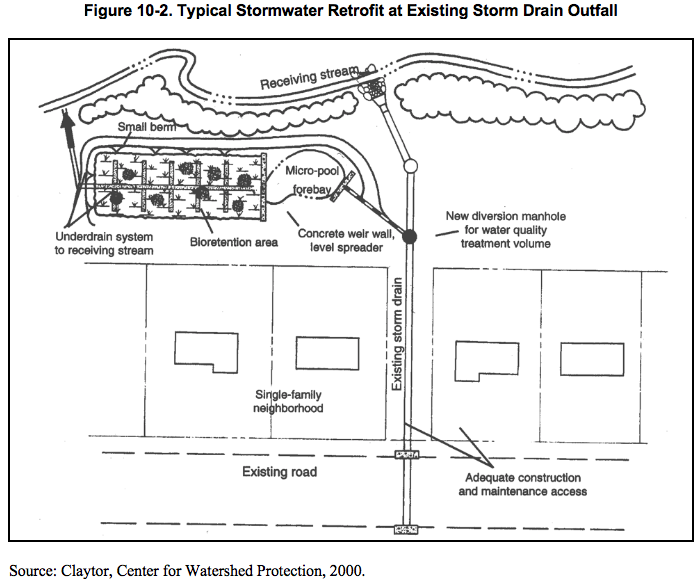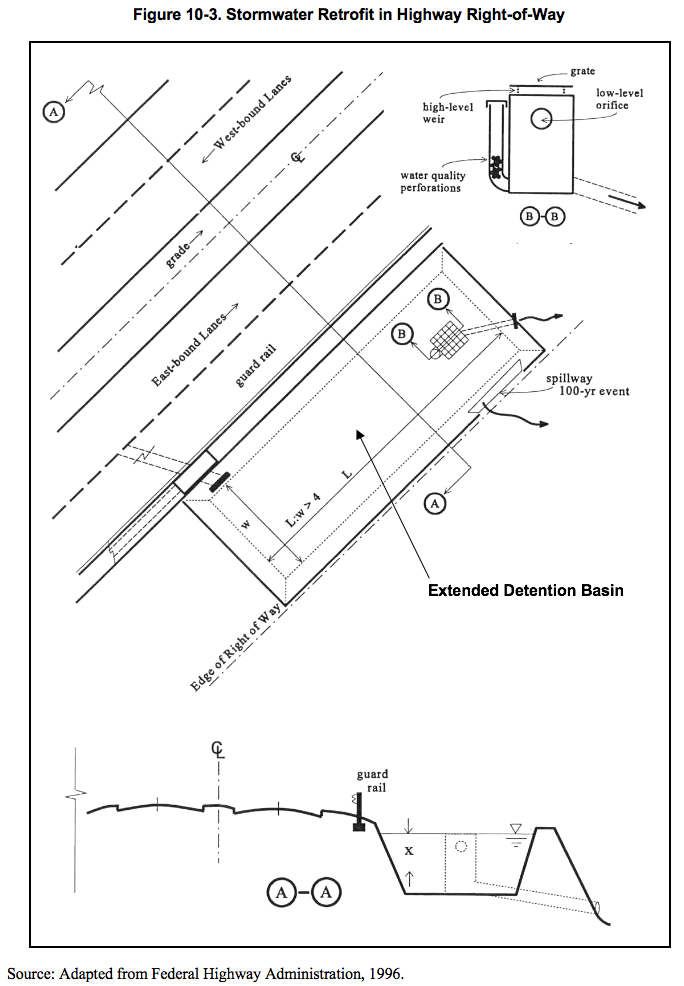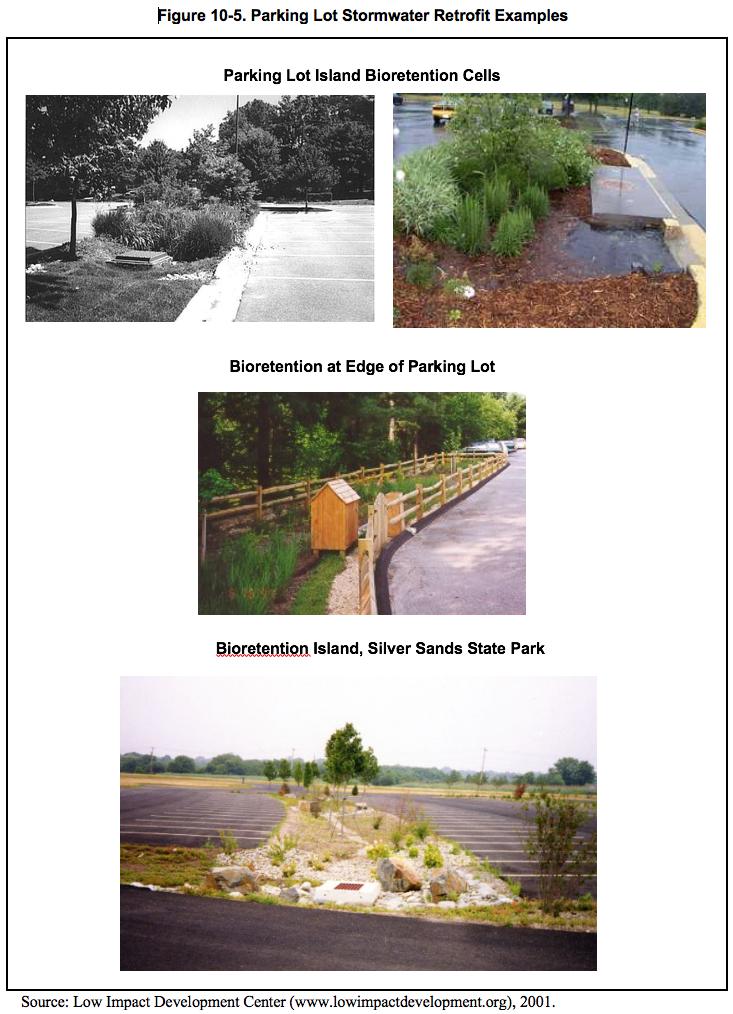10.1 Introduction
Existing development can be modified to incorporate source controls and structural stormwater treatment practices. Such modifications are commonly referred to as stormwater retrofits. This chapter describes opportunities and techniques for retrofitting existing, developed sites to improve or enhance water quality mitigation functions. This chapter also identifies the conditions for which stormwater retrofits are appropriate, as well as the potential benefits and effectiveness of stormwater retrofits.
10.2 Objectives and Benefits of Stormwater Retrofits
The objective of stormwater retrofitting is to remedy problems associated with and improve water quality mitigation functions of older, poorly designed, or poorly maintained stormwater management systems. In Connecticut, prior to the 1970s, site drainage design did not require stormwater detention for controlling post-development peak flows. As a result, drainage, flooding, and erosion problems are common in many older developed areas of the state. Furthermore, a majority of the stormwater detention facilities throughout the state have been designed to control peak flows, without regard for water quality mitigation. Therefore, many existing stormwater detention basins provide only minimal water quality benefit.
Incorporating stormwater retrofits into existing developed sites or into redevelopment projects can reduce the adverse impacts of uncontrolled stormwater runoff. This can be accomplished through reduction in unnecessary impervious cover, incorporation of small-scale Low Impact Development (LID) management practices, and construction of new or improved structural stormwater treatment practices. One of the primary benefits of stormwater retrofits is the opportunity to combine stormwater quantity and quality controls. Stormwater retrofits can also remedy local nuisance conditions and maintenance problems in older areas, and improve the appearance of existing facilities through landscape amenities and additional vegetation.
10.3 When is Retrofitting Appropriate?
Site constraints commonly encountered in existing, developed areas can limit the type of stormwater retrofits that are possible for a site and their overall effectiveness. Retrofit of an existing stormwater management facility according to the design standards contained in Chapter Eleven of this manual may not be possible due to site-specific factors such as the location of existing utilities, buildings, wetlands, maintenance access, and adjacent land uses. Table 10-1 lists site-specific factors to consider in determining the appropriateness of stormwater retrofits for a particular site.
Table 10-1. Site Considerations for Determining the Appropriateness of Stormwater Retrofits
Factor
|
Consideration |
| Retrofit Purpose | What are the primary and secondary (if any) purposes of the retrofit project? Are the retrofits designed primarily for stormwater quantity control, quality control, or a combination of both? |
| Construction/Maintenance Access | Does the site have adequate construction and maintenance access and sufficient construction staging area? Are maintenance responsibilities for the retrofits clearly defined? |
| Subsurface Conditions | Are the subsurface conditions at the site (soil permeability and depth to groundwater/bedrock) consistent with the proposed retrofit regarding subsurface infiltration capacity and constructability? |
| Utilities | Do the locations of existing utilities present conflicts with the proposed retrofits or require relocation or design modifications? |
| Conflicting Land Uses | Are the retrofits compatible with adjacent land uses of nearby properties? |
| Wetlands, Sensitive Water Bodies, and Vegetation | How do the retrofits affect adjacent or downgradient wetlands, sensitive receiving waters, and vegetation? Do the retrofits minimize or mitigate impacts where possible? |
| Complementary Restoration Projects | Are there opportunities to combine stormwater retrofits with complementary projects such as stream stabilization, habitat restoration, or wetland restoration/mitigation? |
| Permits and Approvals | Which local, state, and federal regulatory agencies have jurisdiction over the proposed retrofit project, and can regulatory approvals be obtained for the retrofits? |
| Public Safety | Does the retrofit increase the risk to public health and safety? |
| Cost | What are the capital and long-term maintenance costs associated with the stormwater retrofits? Are the retrofits cost-effective in terms of anticipated benefits? |
Source: Adapted from Claytor, Center for Watershed Protection, 2000.
Retrofitted facilities may not be as effective in reducing pollutant loads, for example, as newly designed and installed facilities. However, in most cases, some improvements in stormwater quantity and quality control are possible, especially if a new use is planned for an existing development or an existing storm drainage system is upgraded or expanded. Incorporation of a number of small-scale LID management practices or a treatment train approach may be necessary to achieve the desired level of effectiveness. It should also be recognized that stormwater quantity frequently creates the most severe impacts to receiving waters and wetlands as a result of channel erosion (Claytor, Center for Watershed Protection, 2000). Therefore, stormwater quantity control functions that existing stormwater management facilities provide should not be significantly compromised in exchange for pollutant removal effectiveness.
10.4 Stormwater Retrofit Options
Stormwater retrofit options include many of the source control and stormwater treatment practices for new developments that are described in other chapters of this manual. Common stormwater retrofit applications for existing development and redevelopment projects include:
- Stormwater drainage system retrofits
- Stormwater management facility retrofits
- New stormwater controls at storm drain outfalls
- New stormwater controls for road culverts and rights-of-way
- In-stream practices in existing drainage channels
- Parking lot stormwater retrofits
- Wetland creation and restoration
Examples of these stormwater retrofits are described in the following sections.
10.4.1 Stormwater Drainage Systems
Existing drainage systems can be modified to improve water quality mitigation and sediment removal functions. These retrofits alone typically provide limited benefits, but are most successful when used in conjunction with other source controls and stormwater treatment practices. Due to their very nature as an integral part of the stormwater collection and conveyance system and inherent solids trapping function, these retrofits typically have high maintenance requirements. Common examples of stormwater drainage system retrofits include:
- Deep Sump Catch Basins with Hoods: Older catch basins without sumps can be replaced with catch basins having four to six-foot deep sumps. Sumps provide storage volume for coarse sediments, provided that accumulated sediment is removed on a regular basis. Hooded outlets, which are covers over the catch basin outlets that extend below the standing water, can also be used to trap litter and other floatable materials. A recent study conducted in New York City demonstrated that catch basins equipped with hoods increase the capture of floatables by 70 to 80 percent over catch basins without hoods and greatly extend the cleaning interval without degraded capture performance (Pitt, 1999 in NRDC, 1999).
- Catch Basin Inserts and Storm Drain Structures: As discussed in Chapter Six, a number of manufactured devices have been developed that can be inserted into storm drains or catch basins to capture sediment and other pollutants directly beneath the grate. These products typically utilize filter media or vortex action for removal of solids from incoming stormwater runoff. These devices are ideally suited for developed sites since they fit inside of or replace existing catch basins, or are installed beneath existing parking lots with minimal or no additional space requirements.
10.4.2 Stormwater Management Facilities
Existing stormwater management facilities originally designed for flood control can be modified or reconfigured for water quality mitigation purposes or increased hydrologic benefit. Older detention facilities offer the greatest opportunity for this type of retrofit. Traditional dry detention basins can be modified to become extended detention basins, wet ponds, or stormwater wetlands for enhanced pollutant removal. This is one of the most common and easily implemented retrofits since it typically requires little or no additional land area, utilizes an existing facility for which there is already some resident acceptance of stormwater management, and involves minimal impacts to environmental resources (Claytor, Center for Watershed Protection, 2000).
Specific modifications to existing detention basins for improved water quality mitigation are summarized in Table 10-2. Stormwater detention basin retrofits should include an evaluation of the hydraulic characteristics and storage capacity of the basin to determine whether available storage exists for additional water quality treatment. A typical retrofit of an existing detention basin is shown in Figure 10-1.
Table 10-2. Detention Basin Retrofits for Improved Water Quality Mitigation
| Excavate the basin bottom to create more permanent pool storage | Eliminate low-flow bypasses |
| Raise the basin embankment to obtain additional storage for extended detention | Incorporate stilling basins at inlets and outlets and sediment forebays at basin inlets |
| Modify the outfall structure to create a two-stage release to better control small storms while not significantly compromising flood control detention for large storms | Regrade the basin bottom to create a wetland area near the basin outlet or revegetate parts of the basin bottom with wetland vegetation to enhance pollutant removal, reduce mowing, and improve aesthetics |
| Increase the flow path from inflow to outflow and eliminate short-circuiting by using baffles, earthen berms, or micro-pond topography to increase residence time of water in the pond and improve settling of solids | Create a wetland shelf along the perimeter of a wet basin to improve shoreline stabilization, enhance pollutant filtering, and enhance aesthetic and habitat functions |
| Replace paved low-flow channels with meandering vegetated swales | Create a low maintenance “no-mow” wildflower ecosystem in the drier portions of the basin |
| Provide a high flow bypass to avoid resuspension of captured sediment/pollutants during high flows |
Source: Adapted from Claytor, Center for Watershed Protection, 2000; Pennsylvania Association of Conservation Districts et al., 1998; and NJDEP, 2000.

10.4.3 Storm Drain Outfalls
New stormwater treatment practices can be constructed at the outfalls of existing drainage systems. The new stormwater treatment practices are commonly designed as off-line devices to treat the water quality volume and bypass larger storms. Water quality swales, bioretention, sand filters, constructed wetlands, and wet ponds are commonly used for this type of retrofit, although most stormwater treatment practices can be used for this type of retrofit given enough space for construction and maintenance. Figure 10-2 shows a schematic of an existing outfall retrofitted with an off-line bioretention area. Manufactured, underground treatment devices such as those described in Chapter Six are also commonly installed as off-line retrofits at or upgradient of stormwater outfalls. Velocity dissipation devices such as plunge pools and level spreaders can also be incorporated into the retrofit design.

10.4.4 Highway Rights-of-Way
Open spaces associated with highway rights-of-way such as medians, shoulders, and cloverleaf areas also present opportunities to incorporate new stormwater treatment practices. Common treatment practices used in these types of retrofits include vegetated swales, bioretention, constructed wetlands, and extended detention ponds. Traffic, safety, and maintenance access are important considerations for determining appropriate locations for highway right-of-way retrofits. Figure 10-3 shows a schematic of an extended detention basin incorporated into an existing highway right-of-way.

10.4.5 Parking Lots
Parking lots can be ideal candidates for a wide range of stormwater retrofits. Potentially applicable retrofits include site planning techniques and small-scale management measures to reduce impervious coverage and promote increased infiltration (Chapter Four), as well as a variety of larger, end-of-pipe treatment practices. Redevelopment of older commercial properties, which were often designed with oversized parking lots and almost 100 percent impervious coverage, is one of the most common and environmentally beneficial opportunities for parking lot stormwater retrofits.
Alternative site design and LID management practices are well-suited to existing developed areas because most of these practices use a small amount of land and are easily integrated into existing parking areas. Examples of these parking lot stormwater retrofits include:
- Incorporating Bioretention Into Parking Lot Islands and Landscaping: Parking lot islands, landscaped areas, and tree planter boxes can be converted into functional bioretention areas and rain gardens to reduce and treat stormwater runoff.
- Removing Curbing and Adding Slotted Curb Stops: Curbs along the edge of parking lots can sometimes be removed or slotted to re-route runoff to vegetated areas, buffer strips, or bioretention facilities. The capacity of existing swales may need to be evaluated and expanded, where necessary, as part of this retrofit option.
- Infiltrating Clean Roof Runoff From Buildings: In some instances, building roof drains connected to the stormwater drainage system can be disconnected and re-directed to vegetated areas, buffer strips, bioretention facilities, or infiltration structures (dry wells or infiltration trenches).
- Incorporating New Treatment Practices at the Edge of Parking Lots: New stormwater treatment practices such as bioretention, sand filters, and constructed wetlands can often be incorporated at the edge of large parking lots.
- Use of Permeable Paving Materials: Existing impermeable pavement in overflow parking or other low-traffic areas can sometimes be replaced with alternative, permeable materials such as modular concrete paving blocks, modular concrete or plastic lattice, or cast-in-place concrete grids. Site-specific factors including traffic volumes, soil permeability, maintenance, sediment loads, and land use must be carefully considered for the successful application of permeable paving materials for new development or retrofit applications.
Figure 10-4 and Figure 10-5 depict some of the parking lot stormwater retrofits described above.


10.4.6 In-stream Practices in Drainage Channels
Existing (man-made) channelized streams and drainage conveyances such as grass channels can be modified to reduce flow velocities and enhance pollutant removal. Weir walls or riprap check dams placed across a channel create opportunities for ponding, infiltration, and establishment of wetland vegetation upstream of the retrofit (Claytor, Center for Watershed Protection, 2000). In-stream retrofit practices include stream bank stabilization of eroded areas and placement of habitat improvement structures (i.e., flow deflectors, boulders, pools/riffles, and low-flow channels) in impacted natural streams and along stream banks. In-stream retrofits may require evaluation of potential flooding and floodplain impacts resulting from altered channel conveyance, as well as local, state, or federal approval for work in wetlands and watercourses. More comprehensive urban stream and stream corridor restoration practices are beyond the scope of this manual. Additional sources of information on stream restoration practices are included at the end of this chapter.
10.4.7 Wetland Creation and Restoration
Wetland creation or restoration can partially substitute for lost ecological functions of a destroyed or degraded wetland system in developed areas. Creation or restoration of freshwater or tidal wetlands can improve the pollutant removal, longevity, adaptability, and habitat functions of wetland systems (DEP, 1995). Techniques to improve pollutant removal in created or restored wetlands include (Schueler et al., 1992):
- Increasing wetland volume to increase residence time
- Increasing the surface area to volume ratio of the wetland
- Increasing the flow path through the wetland
- Providing energy dissipation and primary sedimentation either prior to the wetland or in a sediment forebay at the wetland inflow locations
- Integrating with other treatment practices such as extended detention.
When wetlands are altered through clearing of vegetation, impoundment of water, or dredging, the microhabitats used by many wildlife species are changed or lost. This may result in unsuitable breeding habitat for many amphibians, including vernal pool species. Similarly, created wetlands usually lack the structural diversity, microhabitats, and hydrology to support vernal pool breeding amphibians (Calhoun and Klemens 2002). Altered and created wetlands often support highly adaptable, widespread, “weedy” species (e.g., bullfrogs or green frogs) that prey upon, or successfully out-compete, vernal pool-breeding amphibians, which reduces or locally eliminates populations of these habitat specialists. Created wetlands that do not have the appropriate habitat often attract breeding amphibians, which serve as “decoy” pools and trap breeding amphibians. Therefore, these wetland creation and restoration techniques should only be implemented with careful consideration of the effects to wetland function and hydrology and in conjunction with applicable local, state, and federal wetland and watercourses regulatory agencies.
Additional Information Sources
Riley, A.L. 1998. Restoring Streams in Cities. Island Press. Washington, D.C.
Federal Interagency Stream Restoration Working Group. 1998. Stream Corridor Restoration-Principles, Processes, and Practices.
References
Calhoun, A.J.K. and M.W. Klemens. 2002. Best development practices: Conserving pool-breeding amphibians in residential and commercial developments in the northeastern United States. MCA Technical Paper No. 5, Metropolitan Conservation Alliance, Wildlife Conservation Society, Bronx, New York.
Center for Watershed Protection (CWP). 2000. The Practice of Watershed Protection. Ellicott City, Maryland.
Connecticut Department of Environmental Protection (DEP). 1995. Connecticut Stormwater Quality Planning: A Guide for Municipal Officials and Regional Planners (draft). Bureau of Water Management. Planning and Standards Division. Hartford, Connecticut.
Natural Resources Defense Council (NRDC). 1999. Stormwater Strategies: Community Responses to Runoff Pollution.
New Jersey Department of Environmental Protection (NJDEP). 2000. Revised Manual for New Jersey: Best Management Practices for Control of Nonpoint Source Pollution from Stormwater, Fifth Draft, May 3, 2000.
Pennsylvania Association of Conservation Districts, Keystone Chapter Soil and Water Conservation Society, Pennsylvania Department of Environmental Protection, and Natural Resources Conservation Service. 1998. Pennsylvania Handbook of Best Management Practices for Developing Areas, prepared by CH2MHILL.
Pitt, R. 1999. Department of Civil and Environmental Engineering, University of Alabama at Birmingham.
Schueler, T.R., Kumble, P.A., and M.A. Heraty. 1992. A Current Assessment of Urban Best Management Practices: Techniques for Reducing Non-Point Source Pollution in the Coastal Zone. Department of Environmental Programs. Metropolitan Washington Council of Governments.